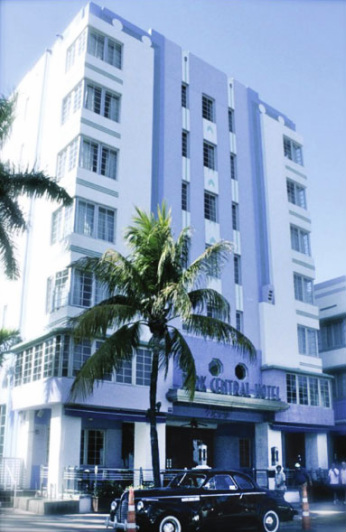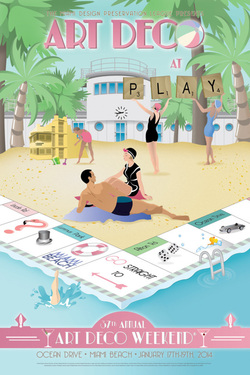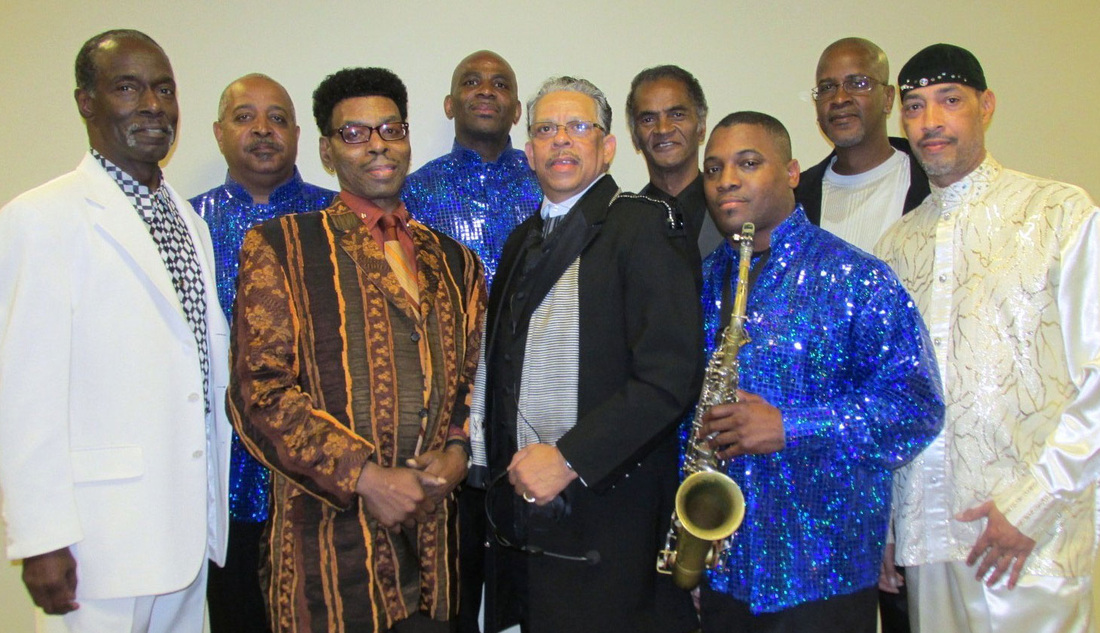Tell us about your upcoming event. Click here to email your news releases and photos and we will list them on this page. Please send listings at least three weeks before your event. You can also tell us about your event in the comments section at the bottom of this page.
Antiques program highlights Art Deco Weekend
 Photo: Miami Design Preservation League
Photo: Miami Design Preservation League
Lectures and demonstrations about antiquing take center stage at this year's 37th Annual Art Deco Weekend along Ocean Drive in Miami Beach, with several experts offering advice on how to select antiques from the Art Deco era.
Presenters include Gary Sohmers, an appraiser for 13 seasons of the "Antiques Roadshow" program on PBS; Rick Emmet, of the International Appraisers Association and an expert in French and American Art Deco; and Gary Moss, former owner of Kenmore Cards sports memorabilia shop near Fenway Park in Boston. Moss will discuss the history and evolution of toys from the 1920s through 50s.
The presentations are just part of the eclectic mix of music, food, children's activities, antique cars, fashion shows, tours and street entertainment that the festival has been presenting since 1978 in the city's Art Deco Architectural Historic District.
Ocean Drive is closed each year for the festival, which takes place along the edge of Lummus Park. More than 140 vendors will offer items including vintage clothing, art and jewelry. New this year is the Antique Experience tents at 11th Street. One tent features Art Deco antiques while the other will house mid-century Modern furniture.
The theme of this year's festival is "Play," featuring a children's playground, an antique toy exhibit at the Welcome Center and the Kid-at-Heart Film series. The "Arf Deco" dog parade returns on Saturday as well.
Walking tours of the Art Deco District, a mainstay of the annual festival, will be led by architects, designers, preservationists and historians. All are trained at the Tour School held twice a year by the festival's sponsor, the Miami Design Preservation League.
• Learn more at the Art Deco Weekend website • Download the Art Deco Weekend program • Find out how you can help preserve Miami Beach's Art Deco architecture at Miami Design Preservation League's website
Presenters include Gary Sohmers, an appraiser for 13 seasons of the "Antiques Roadshow" program on PBS; Rick Emmet, of the International Appraisers Association and an expert in French and American Art Deco; and Gary Moss, former owner of Kenmore Cards sports memorabilia shop near Fenway Park in Boston. Moss will discuss the history and evolution of toys from the 1920s through 50s.
The presentations are just part of the eclectic mix of music, food, children's activities, antique cars, fashion shows, tours and street entertainment that the festival has been presenting since 1978 in the city's Art Deco Architectural Historic District.
Ocean Drive is closed each year for the festival, which takes place along the edge of Lummus Park. More than 140 vendors will offer items including vintage clothing, art and jewelry. New this year is the Antique Experience tents at 11th Street. One tent features Art Deco antiques while the other will house mid-century Modern furniture.
The theme of this year's festival is "Play," featuring a children's playground, an antique toy exhibit at the Welcome Center and the Kid-at-Heart Film series. The "Arf Deco" dog parade returns on Saturday as well.
Walking tours of the Art Deco District, a mainstay of the annual festival, will be led by architects, designers, preservationists and historians. All are trained at the Tour School held twice a year by the festival's sponsor, the Miami Design Preservation League.
• Learn more at the Art Deco Weekend website • Download the Art Deco Weekend program • Find out how you can help preserve Miami Beach's Art Deco architecture at Miami Design Preservation League's website
 Poster: Miami Design Preservation League
Poster: Miami Design Preservation League
What is Art Deco?
From Miami Design Preservation League website
In the United States, Art Deco was a product of new ideas and movements and found its inspirations in many distinct early 20th Century European design styles such as Cubism, French Art Deco, German Bauhaus and Expressionism, Dutch de Stijl and Amsterdam School, Vienna Secession and others.
The term Art Deco came into common usage in the 1980s as public interest in the style was renewed and is generally used to cover several distinct periods. Art Deco became known as the Skyscraper Style for the buildings that sprang up in every big city in the mid to late 1920s. This was classical Art Deco, as first popularized at the Exposition Internationale des Arts Décoratifs et Industriels Modernes held in Paris in 1925, featuring expensive materials, angular yet voluptuous with elaborate motifs of fountains, nudes and flora.
Miami Beach’s building boom came during the second phase of Art Deco known as Streamline Moderne, which began with the stock market crash and ended in most cases with the outbreak of World War II. It was less decorative—a more sober reflection of the Great Depression. It relied more on machine-inspired forms, and American ideas in industrial design. It was buttressed by the belief that times would get better and was infused with the optimistic futurism extolled at America’s Worlds Fairs of the 1930s. Stripped Classic or Depression Moderne was a sub-style often used for governmental buildings, the U.S. Post Office being the best example in Miami Beach. Miami Beach architects used local imagery to create what we now call Tropical Deco. These buildings feature relief ornamentation featuring whimsical flora, fauna and ocean-liner motifs to reinforce the image of Miami Beach as a seaside resort.
What to look for: Over-all symmetry, ziggurat (stepped) rooflines, glass block, decorative sculptural panels, eyebrows, round porthole windows, terrazzo floors, curved edges and corners, elements in groups of three, neon lighting (used in both exteriors as well as interior spaces).
From Miami Design Preservation League website
In the United States, Art Deco was a product of new ideas and movements and found its inspirations in many distinct early 20th Century European design styles such as Cubism, French Art Deco, German Bauhaus and Expressionism, Dutch de Stijl and Amsterdam School, Vienna Secession and others.
The term Art Deco came into common usage in the 1980s as public interest in the style was renewed and is generally used to cover several distinct periods. Art Deco became known as the Skyscraper Style for the buildings that sprang up in every big city in the mid to late 1920s. This was classical Art Deco, as first popularized at the Exposition Internationale des Arts Décoratifs et Industriels Modernes held in Paris in 1925, featuring expensive materials, angular yet voluptuous with elaborate motifs of fountains, nudes and flora.
Miami Beach’s building boom came during the second phase of Art Deco known as Streamline Moderne, which began with the stock market crash and ended in most cases with the outbreak of World War II. It was less decorative—a more sober reflection of the Great Depression. It relied more on machine-inspired forms, and American ideas in industrial design. It was buttressed by the belief that times would get better and was infused with the optimistic futurism extolled at America’s Worlds Fairs of the 1930s. Stripped Classic or Depression Moderne was a sub-style often used for governmental buildings, the U.S. Post Office being the best example in Miami Beach. Miami Beach architects used local imagery to create what we now call Tropical Deco. These buildings feature relief ornamentation featuring whimsical flora, fauna and ocean-liner motifs to reinforce the image of Miami Beach as a seaside resort.
What to look for: Over-all symmetry, ziggurat (stepped) rooflines, glass block, decorative sculptural panels, eyebrows, round porthole windows, terrazzo floors, curved edges and corners, elements in groups of three, neon lighting (used in both exteriors as well as interior spaces).
Fairs and Festivals
January
|
17-19 - Art Deco Weekend - Presented by The Miami Design Preservation League. Three-day event along Ocean Drive in Miami Beach, features live music, film, antique shows, fashion shows, auto show, children's playground, vintage toys, interactive games, art deco tours, lectures and the "Arf Deco Dog Parade." For more details, including parking and hotel links, go to the web site: www.artdecoweekend.com
Jan. 31 - Feb. 2 - Treasure Coast Pirate Fest - 2-8 p.m. on Jan. 31; 10 a.m.-8 p.m. on Feb. 1; 10 a.m.-4 p.m. on Feb. 2. Veterans Memorial Park / Riverwalk Center, 600 North Indian River Drive, Fort Pierce, FL 34950 Donation $1. More information: (561) 792-9260 or http://www.treasurecoastpiratefest.com/ |
16-25 - Tampa Bay Black Heritage Festival - 10-day celebration leading up to the Martin Luther King holiday features live entertainment, cultural events, health and money management workshops, speakers, music festival with national recording artists, food and craft vendors and more. Music highlights include free concert by 70s funk group The Ohio Players on Jan. 18; a gospel concert by Jonathan McReynolds ($10 advance; $15 VIP seating; $25 VIP seating and reception); and The Gershwins' Porgy and Bess at Straz Center for the Performing Arts. (See website for ticket ordering details). More info: tampablackheritage.org
31-Feb. 2 - Big Cypress Shootout - Three-day series of educational demonstrations and historical battles depicting the struggles of the Seminole Indians to remain in their homeland during the Second Seminole War of 1835 to 1842. Re-enactments take place Feb. 1 and 2 at Billie Swamp Safari, located between Fort Lauderdale and Naples on the Big Cypress Reservation just north of I-75 (Alligator Alley), Exit 49. Tickets are $10 adults, $6 children. More info: 800-949-6101 or www.bcshootout.com |

